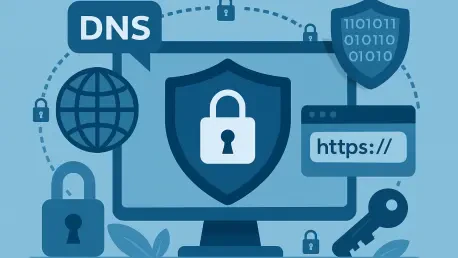Imagine a world where every online step you take—every website visited, every search made—is quietly logged by your Internet Service Provider (ISP), potentially sold to advertisers or exposed to prying eyes. This isn’t a distant dystopia but a reality for many internet users today, as traditional Domain Name System (DNS) queries remain unencrypted and vulnerable to interception. DNS, often described as the internet’s phone book, translates human-readable domain names into machine-friendly IP addresses, but without protection, it exposes a user’s digital footprint. Enter DNS over HTTPS (DoH) and DNS over TLS (DoT), two encrypted DNS protocols designed to shield browsing habits from surveillance. These technologies are reshaping how privacy is maintained online, offering a robust defense against ISP tracking and other threats. By diving into their mechanisms, challenges, and broader implications, a clearer picture emerges of how they empower users to reclaim control over personal data in an era of pervasive monitoring.
Understanding Encrypted DNS Protocols
Securing the Internet’s Core Function
At the heart of internet navigation lies DNS, a system that ensures seamless access to websites by converting domain names into IP addresses, yet its unencrypted nature has long been a privacy Achilles’ heel. Without safeguards, ISPs and even malicious actors on public networks can intercept these queries, gaining insight into every site a user visits. DoH and DoT tackle this vulnerability head-on by encrypting DNS requests, rendering them unreadable to unauthorized parties. DoH embeds queries within HTTPS traffic, blending them into the vast stream of encrypted web activity, which makes it incredibly difficult for ISPs to isolate or monitor specific requests. DoT, on the other hand, uses a dedicated TLS-encrypted channel on port 853, providing a secure but more identifiable pathway. Both approaches prevent ISPs from logging detailed browsing histories, fundamentally disrupting their ability to monetize user data. This shift marks a significant step toward ensuring that online activities remain private, even in environments prone to surveillance like unsecured Wi-Fi hotspots.
Comparing Strengths in Privacy Protection
While both DoH and DoT aim to secure DNS queries, their effectiveness in maintaining anonymity and evading interference varies due to inherent design differences. DoH’s integration with HTTPS traffic offers a stealth advantage, as it becomes nearly indistinguishable from regular web interactions, reducing the likelihood of targeted blocking by ISPs or restrictive networks. This blending capability makes it a preferred choice for users in regions with heavy censorship, where maintaining access to information is critical. Conversely, DoT’s reliance on a distinct port makes it more susceptible to throttling or outright bans by entities that can identify and filter traffic on port 853. Despite this, DoT provides robust encryption that stands up to most interception attempts, appealing to users prioritizing security over evasion. The choice between these protocols often depends on specific needs—whether blending into traffic or ensuring ironclad encryption takes precedence. Understanding these nuances helps users make informed decisions about safeguarding their digital presence against ISP overreach.
Challenges and Future of Encrypted DNS
Navigating Implementation Hurdles
Adopting encrypted DNS protocols like DoH and DoT isn’t without obstacles, as technical and practical barriers can hinder seamless integration for both individuals and organizations. Setting up DoH often requires selecting a compatible resolver from providers like Cloudflare or Google, and while major browsers increasingly offer built-in support, some users still need extensions or manual configurations, which can be daunting for the less tech-savvy. DoT setup may involve adjusting firewall settings to allow traffic on port 853, a step easily overlooked by casual users, potentially leaving security gaps. Additionally, while technologies like DNSSEC ensure query integrity by preventing tampering, they don’t encrypt data on their own, meaning they must be paired with DoH or DoT for full protection. Even with encryption, ISPs can still infer visited sites through IP addresses unless combined with tools like VPNs. These complexities highlight the need for user education and streamlined solutions to make encrypted DNS more accessible to the masses.
ISP Resistance and Economic Motives
A significant roadblock to the widespread adoption of encrypted DNS stems from ISPs themselves, whose business models often rely on harvesting user data for profit, creating tension between privacy and corporate interests. Many ISPs justify their opposition by citing the need for DNS visibility to manage networks or enable features like parental controls, but the underlying motive frequently ties back to monetization through data sales to advertisers. Encrypted protocols, especially DoH, disrupt this revenue stream by obscuring browsing details, prompting some providers to downplay the benefits of encryption or push less effective alternatives. This resistance isn’t merely technical but reflects a broader struggle over who controls online information—users or corporations. As encrypted DNS gains traction, ISPs may be forced to adapt, but their pushback underscores a critical challenge: balancing user empowerment with the economic realities of internet infrastructure. The outcome of this clash will likely shape privacy norms for years to come.
Evolving Standards and User Empowerment
Looking ahead, the landscape of encrypted DNS reflects a promising trajectory, with innovations like Encrypted Client Hello (ECH) building on DoH to further obscure metadata and enhance privacy protections. Experts anticipate that as adoption grows, ISPs might shift away from data-driven revenue models, though resistance lingers due to concerns over threat detection, such as identifying malware communications through DNS traffic. Despite these debates, a clear trend emerges—users increasingly demand control over their personal data, driving the evolution of encryption standards. The consensus among privacy advocates is that while DoH and DoT mark significant strides in shielding online activities from surveillance, their effectiveness hinges on context, awareness, and complementary tools. Reflecting on these developments, the push for stronger privacy measures gains undeniable momentum, setting the stage for a future where digital autonomy becomes a cornerstone of internet use. Moving forward, stakeholders should prioritize simplifying implementation and fostering collaboration to ensure these technologies reach their full potential in redefining online security.









